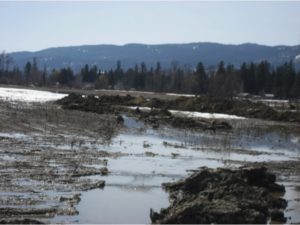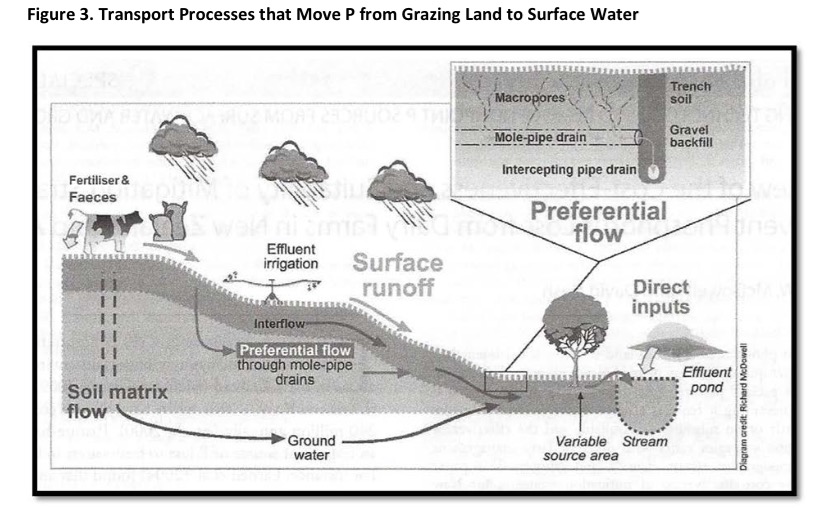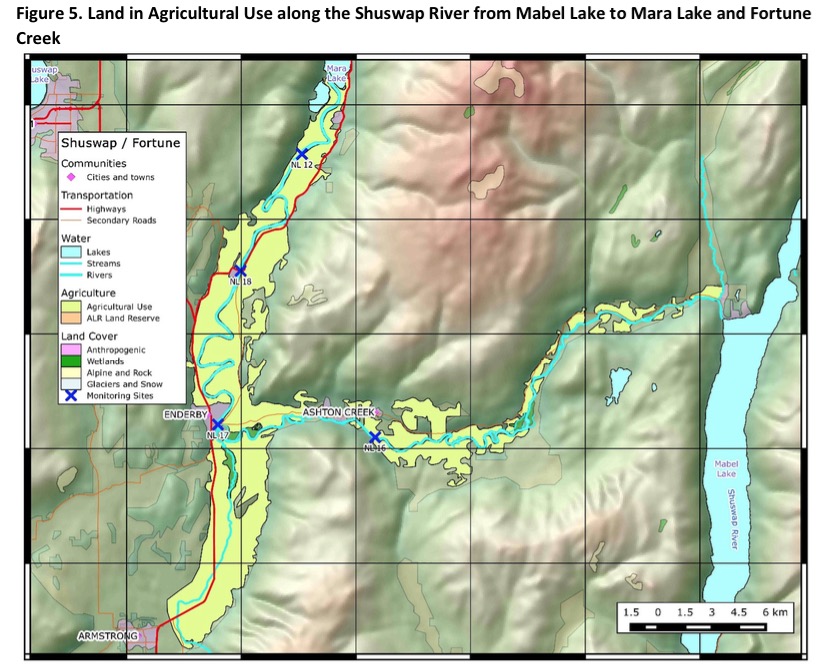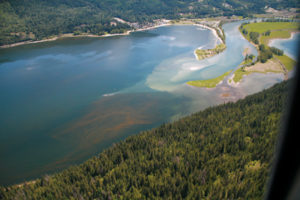We cannot afford to go backwards. The current debate within local governments about how to fund the ongoing work of the Shuswap Watershed Council is almost too painful to observe. So much good work has been done, particularly the latest report that looks at farming practices, it would be absurd to lose the Council now because our local politicians cannot agree on where the funding should come from. The new report outlines a work plan that will lead to improvements, but the Council needs continued commitment, collaboration, and secure funding.
Every local politician should be at least required to read the executive summary of Agricultural Nutrient Management in the Shuswap Watershed for Maintaining and improving Water Quality: Literature Review and Nutrient Management Strategies.
 Manure laden water on this field flows into the Shuswap River during spring run-off
Manure laden water on this field flows into the Shuswap River during spring run-off
Over the years, I have been alerted to obvious examples of manure laden snowmelt water flowing into the rivers and I have witnessed and photographed the problems and often notified government agencies. Finally, there is a report that analyzes these problems by going into detail about how phosphorus enters watersheds from agricultural operations and describes the mitigation strategies needed to reduce nutrient loading and thus help improve and protect water quality.
 This report was prepared as a result of water quality monitoring data collected by SLIPP between 2011 and 2013 that showed high levels of phosphorus entering the Shuswap, Eagle and Salmon Rivers during the spring snowmelt and the late spring-early summer periods. The literature shows that managing farmland to maximize yields often leads to “legacy phosphorus” forming in the soil which can take many years to decline after cession of manure or fertilizer applications. The two major sources are particulate phosphorus from eroding soil and dissolved phosphorus from surface runoff and subsurface flow, which is best suited for stimulating the growth of algae.
This report was prepared as a result of water quality monitoring data collected by SLIPP between 2011 and 2013 that showed high levels of phosphorus entering the Shuswap, Eagle and Salmon Rivers during the spring snowmelt and the late spring-early summer periods. The literature shows that managing farmland to maximize yields often leads to “legacy phosphorus” forming in the soil which can take many years to decline after cession of manure or fertilizer applications. The two major sources are particulate phosphorus from eroding soil and dissolved phosphorus from surface runoff and subsurface flow, which is best suited for stimulating the growth of algae.
A recent survey of fields along the Shuswap River between Enderby and Mara found that 36 percent had high levels of phosphorus and 50 percent had very high levels (above 100 ppm soil P). Only 20-30 ppm P is needed to provide the phosphorus requirements to grow a crop for one year. Also, 96 percent of the fields were considered to pose a potentially high to very high risk of phosphorus leaching or running off into surface water.
 Map from report showing extensive farm land adjacent to the Shuswap River and Fortune Creek
Map from report showing extensive farm land adjacent to the Shuswap River and Fortune Creek
The most intensive area for agriculture is along the Shuswap River below Enderby, with approximately 50 dairy farms and 16 commercial poultry operations. Farming is less intensive adjacent to the Eagle and Salmon Rivers, where there are primarily beef cow-calf operations, hobby farms and just a few dairy and poultry farms. Currently these farms operate with a voluntary guideline for nutrient management. Farmers can be found to be in violation of the agricultural Waste Control Regulation, but this is difficult to enforce. There are no regulations concerning the application of chemical fertilizers.
The report identifies five types of mitigation strategies, beginning with the most obvious, reducing the overall phosphorus loading by reducing its levels in animal feed and by reducing the amount applied to the farmland or improving the timing of applications. Farmers can also identify the critical source areas in the landscape and make modifications to minimize run-off. The use of best management practices such as buffers, tillage, cover crops and stream bank restoration has been shown to be effective. As well, there are phosphorus binding and absorbing materials available to remediate subsurface flow before it is discharged into surface water.
Unfortunately, the research shows that in some areas where legacy phosphorus is persistent in the soils, it can take many years of mitigation efforts before water quality improves. Consequently, efforts need to begin soon in the Shuswap, as the studies indicate, most of the farmland adjacent to the Shuswap River is already heavily laden with phosphorus and thus it could take decades before improvements finally occur.
Yet, as the report shows, the first step is more in-depth water monitoring as although the results so far point to agriculture, there is not yet concrete evidence, nor are the specific mechanisms identified by which agricultural source phosphorus may be entering surface water. This detailed information can then be used to guide a mitigation program that will involve the Council working with the farming community to achieve the results needed to protect our precious lakes and streams. In addition, the Council should help educate residents about our watershed and focus on developing climate change adaptation strategies.
Local politicians need to understand that every resident in the Shuswap benefits from a healthy watershed and thus shares in the responsibility to keep it healthy. Political boundaries need to be put aside in the debate, as the truly equitable funding model would be for each property owner to pay a small yearly tax. And no doubt, most residents would support the cost of a few cups of coffee to pay for protecting the basis of our economy and our well-being – a healthy watershed.
POSTSCRIPT
You can download the report described in the column here:
http://www.fraserbasin.bc.ca/_Library/TR/swc_report_nutrient_management_August_2014_web.pdf
Our environmental organization, Shuswap Environmental Action Society (SEAS) has been working on this issue for many years. You can read more details about water issues at the SEAS website. The impact of elevated concentration of phosphorus from agricultural run-off in Shuswap and Mara Lakes is that this nutrient encourages the growth of algae. This has resulted in two algae blooms in 2008 and 2010, which have never been seen before. It also results in an increase in algae growth every year, which can be seen on boats, docks and buoys. As well, the algae piles on on the shoreline in some areas, reducing the quality of the water. While algae growth is unlikely to result in reducing water quality to the point that it cannot be used for drinking water, it could damage the overall image of the lake as nearly pristine, especially if we continue to get more algae blooms.







